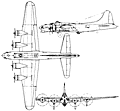 |
Boeing B-17 Flying Fortress1939 |  |
| BOMBER | Virtual Aircraft Museum / USA / Boeing |
 |
Frustrated in their efforts to acquire a fleet of strategic bombers for service with the Army Air Corps, US Army planners - who were devotees of the theories expounded by Brig Gen William 'Billy' Mitchell - inserted the thin end of an important wedge when they ordered a small number of YB-17 prototypes in January 1936, ostensibly for the nation's defence. Originating as the Boeing Model 299, the prototype was built as a private venture, Boeing gambling heavily on producing a winner that would bring a large military contract. It must have seemed to Boeing that their gamble had failed when, almost at the end of the military trials, the Model 299 crashed on take-off. Fortunately investigation proved that the aircraft had been flown off with the flying controls locked and safety of the basic design was not suspect. It was not until 1938 that the USAAC was able to place an order for 39 production B-17B, the last of this batch entering service in March 1940. These were the first B-17 production aircraft to be equipped with turbocharged engines, providing a higher maximum speed and much increased service ceiling. Of the B-17C which followed, a batch of 20 were supplied to the RAF (designated Fortress I) and used operationally in Europe for evaluation, leading to improved B-17D and B-17E aircraft with self-sealing fuel tanks and revised armour and armament. The B-17E was truly a flying fortress, armed with one 7.62mm and 12 12.7mm machine-guns for defence and able to carry a maximum 7,983kg of bombs. Most extensively built variant was the B-17G (8,680), being built by Douglas and Lockheed Vega as well as at the Boeing plant, Seattle. Pratt & Whitney R-1820-97 radial engines and improved turbochargers enabled the B-17G to operate at an altitude of up to 10,670m; and the addition of a chin turret below the nose (containing two 12.7mm machine-guns) provided better defence against the head-on attacks being launched by Luftwaffe fighter pilots in their attempts to reduce the numbers of Fortresses striking daily at strategic targets deep in German territory. Special variants included the B-40 with up to 30 machine-guns/cannons, which was intended as a B-17 escort, but proved to be an operational failure; BQ-7 pilotless aircraft packed with explosives to be deployed against German targets by radio control, which failed due to unreliable control equipment; CB-17 and C-108 transports; and F-9 long-range B-17 equipped to serve as an air-sea rescue aircraft and able to deploy a lifeboat carried beneath the fuselage. In Britain, more than anywhere else in the world, the B-17 evokes vivid memories of courageous aircrew who day after day - despite sometimes horrific losses - continued to attack targets in Europe until victory was won. For Boeing, their private-venture gamble paid off: a total of 12,731 Fortresses were built by the Boeing, Douglas and Lockheed team.

|  COMPANY PROFILE | ||||||||||||||||||||||||||||||||||||||||||||||||||||||||||||
 |

|

